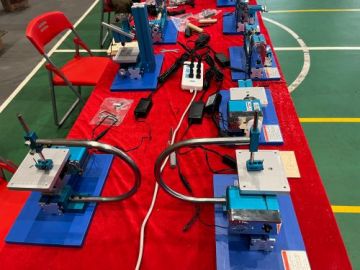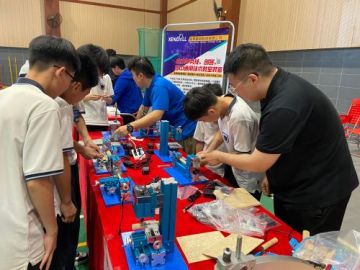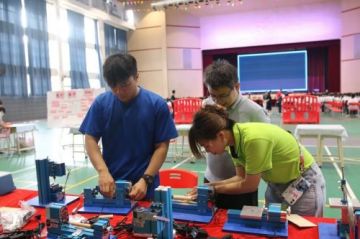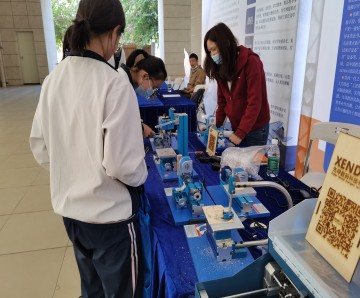Blog
Xendoll has 22 years of experience in the production of small machine tools. We will help you choose the suitable machine and share our experience in CNC machining with you.
 Nov 19, 2024
Nov 19, 2024
 Xendoll
Xendoll
 860
860
With the rapid development of the manufacturing industry, precision machining technology is gradually penetrating various fields. In student experimental teaching, guiding students to understand and master modern manufacturing technologies, especially the use of small-scale metal processing tools, has become an important aspect of developing their engineering skills and innovative thinking. This paper will explore how to combine desktop small metal milling machines, desktop small metal machine tools, laser engraving machines, desktop small metal drilling machines, desktop small metal sanding machines, and other tools to design a comprehensive student experiment. The aim is to help students master the basic operation methods of modern manufacturing technologies and understand the application of these tools in metal processing.

With the continuous development of desktop equipment, many small-scale metal processing machines have entered the educational field. These machines offer high precision and functionality that are gradually approaching traditional large-scale machine tools, but they are smaller in size and more affordable, making them very suitable for educational experiments. By combining the use of these tools, students can gain a deep understanding of the fundamental principles of modern mechanical processing through hands-on practice and develop their engineering design abilities by solving real-world problems.
This experiment will integrate small metal milling machines, small metal machine tools, laser engraving machines, drilling machines, and sanding machines. Through a multi-step processing process, students will understand and master different aspects of metal processing. The experiment covers metal cutting, laser engraving, drilling, surface treatment, and other technologies, helping students cultivate practical skills, engineering capabilities, and teamwork.

Understand the working principles and functions of various small metal processing equipment: Through practical operation, students will learn the usage methods of different equipment and understand their applications in different metal processing techniques.
Master basic metal processing operation skills: Students will learn how to use metal milling machines, drilling machines, laser engraving machines, and sanding machines, mastering the relevant operational techniques.
Enhance students’ engineering design abilities: In this experiment, students will complete the entire process from design to processing, cultivating their ability to solve engineering problems.
Strengthen teamwork and communication skills: Through group collaboration, students will improve their teamwork and engineering communication abilities.
Promote students' understanding of modern manufacturing technologies: This experiment combines various modern manufacturing technologies, allowing students to gain a more comprehensive understanding of different techniques in metal processing.
Improve practical and innovative abilities: By operating different processing tools, students can enhance their hands-on abilities while fostering innovation and critical thinking to solve real-world problems.
Broaden the horizons of engineering education: By combining multiple technological methods, this experiment helps students understand the complementarity of different processing techniques and lays the foundation for future engineering practices.
The task of the experiment is to design and manufacture a simple mechanical part, which should include milling, drilling, laser engraving, and sanding processes. Students will complete the processing of the part according to design requirements and finally assemble and debug it. The entire process includes the following steps:
Students first need to design a simple part using CAD software. The design should involve certain processing challenges and integrate various processing techniques. For example, the design might include plane milling, deep-hole drilling, and laser engraving for marking. After the design is completed, students should analyze the drawing to confirm the equipment and processing steps required.
Based on the design requirements, students will select appropriate metal materials, such as aluminum alloy or steel. Once the material is prepared, students need to perform basic cutting or shaping to ensure the part’s initial shape meets the processing requirements.
The small metal milling machine is typically used for planar milling, slot milling, cutting, and other operations on metal materials. In this step, students will use the small metal milling machine to process the flat surfaces or complex contours of the part. By adjusting the cutting tool, feed rate, and depth, students can learn how to precisely control the cutting process and ensure processing accuracy.
Drilling is a common process in metalworking. In this step, students will use the small metal drilling machine to drill holes in the part according to the design drawing. Students need to master the drilling depth, feed speed, and the use of cutting fluids to ensure the quality and precision of the holes.
The laser engraving machine is a high-precision processing tool used for engraving and marking metal surfaces. In this step, students will use the laser engraving machine to engrave patterns or text on the surface of the part to complete the marking task. Students need to adjust the laser power and engraving speed to ensure the clarity and accuracy of the engraving.
In the final stage of part processing, students will use the small metal sanding machine to perform surface treatment. Sanding helps remove burrs and surface irregularities generated during processing, while also improving the appearance quality of the part. In this process, students will learn how to control the sanding machine to ensure a smooth surface without scratches.
Personal Protection: Students should wear appropriate safety goggles, gloves, and ear protection when operating various machine tools to ensure their safety.
Operational Guidelines: Students should follow the equipment operating procedures when using machines and tools, ensuring that the equipment is in good working condition to prevent accidents.
Safety Checks: Before each use, students should conduct safety checks on the equipment to confirm that all parameters are set correctly and that tools are installed securely.

Through this experiment, students will gain a comprehensive understanding of various small metal processing equipment and develop their practical skills and problem-solving abilities. By engaging in the design, processing, and assembly of parts, students will experience the entire process from theory to practice, gaining a deeper understanding of metal processing technologies. Additionally, through teamwork, students will strengthen their communication and collaboration skills.
The evaluation of the experiment can be done in the following aspects:
Task Completion: Evaluate whether students complete the part design and processing tasks on time and whether they meet the design requirements.
Operational Compliance: Assess whether students follow the operating procedures and maintain safety awareness while using the equipment.
Processing Precision: Evaluate the precision of the parts processed, such as dimensional accuracy, hole precision, and surface finish.
Teamwork and Innovation: Evaluate students’ performance in group cooperation, especially in solving processing difficulties and optimizing designs.

This comprehensive student experiment, by combining desktop small metal milling machines, machine tools, laser engraving machines, drilling machines, and sanding machines, fully demonstrates the application of modern manufacturing technologies in education. The experiment not only helps students master basic metal processing skills but also cultivates their practical engineering capabilities, teamwork, and innovative thinking. As desktop processing equipment becomes more widely available, similar integrated experiments will provide students with more opportunities to engage with and apply modern manufacturing technologies, laying a solid foundation for their future engineering practices.
The products I recommend offer high cost-effectiveness and ease of use, making them ideal for educational purposes. They can effectively help students better understand and master modern manufacturing technologies:Classic kit 8 in ONE



 Show all our samples
Show all our samples
 Provide you with a free quote
Provide you with a free quote
 Answer all the questions you may have
Answer all the questions you may have
 Guided installation and other options
Guided installation and other options